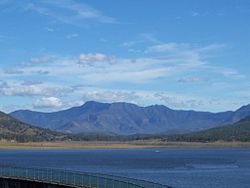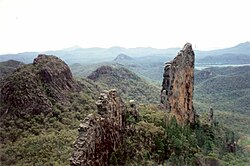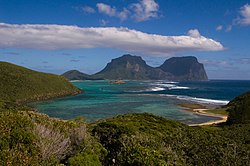Liste von Vulkanen in Australien
In dieser Liste befinden sich Vulkane auf dem australischen Festland und auf australischen Inseln.[1] Der letzte Vulkanausbruch fand 2011 auf der Heard-Insel durch den Big Ben statt.
Vulkane in Australien einschließlich der Inseln
Queensland
New South Wales
Victoria
South Australia
| Bild | Name | Höhe (m) | Lage Geo-Koordinaten | Vulkantyp | Letzte Eruption | Anmerkungen |
|---|---|---|---|---|---|---|
 | Mount Burr Range | — | 37° 33′ 00″ S, 140° 24′ 36″ O | Vulkanfeld | 20.000 Jahre | |
| Newer Volcanics Province | 1,011 | 37° 46′ 12″ S, 142° 30′ 00″ O | Vulkankomplex | 5000 Jahre | Global Volcanism Program | |
 | Mount Gambier (Newer Volcanics Province) | 190 | 37° 50′ 24″ S, 140° 46′ 48″ O | Maare | 4.500 Jahre | John Seach oregonstate.edu |
 | Mount Schank (Newer Volcanics Province) | 158 | 37° 48′ 00″ S, 142° 30′ 00″ O | Aschenkegel | 5.000 Jahre | John Seach oregonstate.edu |
Western Australia
Es gibt keinen aktiven Vulkan in Western Australia, allerdings einige erloschene und den geologischen Nachweis von weiteren. Neunzehn erloschene Vulkane gibt es im Tal des Fitzroy River in der Region von Kimberley, wie auch heiße Quellen, die möglicherweise mit der Aktivität erloschener Vulkane verbunden sind. Es gibt auch Vorkommen von Basalt bei Bunbury und Cape Gosselin.
| Bild | Name | Höhe (m) | Lage Geo-Koordinaten | Vulkantyp | Letzte Eruption | Anmerkungen |
|---|---|---|---|---|---|---|
 | Argyle Diamond Pipe | 16° 36′ 00″ S, 128° 18′ 00″ O | Diatrema | 1,1 bis 1,2 Milliarden Jahre | oregonstate.edu | |
| Ellendale Volcano | — | 17° 29′ 15″ S, 124° 48′ 54″ O | Diatrema | 20 – 22 Millionen Jahre | oregonstate.edu |
Heard und McDonald Islands
| Bild | Name | Höhe (m) | Lage Geo-Koordinaten | Vulkantyp | Letzte Eruption | Anmerkungen |
|---|---|---|---|---|---|---|
| Mount Dixon | 706 | — | — | — | John Seach | |
 | Big Ben oder Mawson Peak | 2.745 | 53° 06′ 22″ S, 073° 30′ 47″ O | Stratovulkan | 2004/2011 | John Seach GVP oregonstate.edu |
| McDonald-Inseln | 230 | 53° 01′ 48″ S, 072° 36′ 00″ O | Komplex | 2005 | John Seach GVP |
Lord Howe Island
| Bild | Name | Höhe (m) | Lage Geo-Koordinaten | Vulkantyp | Letzte Eruption | Anmerkungen |
|---|---|---|---|---|---|---|
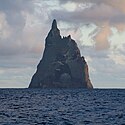 | Ball’s Pyramid | 562 | 31° 30′ 00″ S, 159° 06′ 00″ O | — | — | John Seach oregonstate.edu oregonstate.edu |
 | Mount Gower | 875 | 31° 30′ 00″ S, 159° 06′ 00″ O | — | 3.200 Jahre | John Seach oregonstate.edu |
Tasman Sea
| Bild | Name | Höhe (m) | Lage Geo-Koordinaten | Vulkantyp | Letzte Eruption | Anmerkungen |
|---|---|---|---|---|---|---|
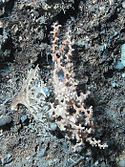 | Tasmanian Seamounts | — | 44° 18′ S, 147° 00′ O | Submarine Vulkane | — | John Seach csiro.au |
| Barcoo Seamount | — | 32° 18′ 00″ S, 156° 18′ 00″ O | Submariner Vulkan | — | John Seach | |
| Britannia Seamount | — | 27° 54′ 00″ S, 155° 35′ 24″ O | Submariner Vulkan | — | John Seach | |
| Derwent-Hunter Seamount | — | 27° 59′ 24″ S, 155° 35′ 24″ O | Submariner Vulkan | — | John Seach Boozle.com | |
| Gascoyne Seamount | — | 36° 40′ 12″ S, 156° 10′ 48″ O | Submariner Vulkan | — | John Seach | |
| Heemskirk Seamount | — | 36° 15′ 00″ S, 159° 24′ 36″ O | Submariner Vulkan | — | John Seach | |
| Queensland Seamount | — | 27° 30′ 00″ S, 155° 06′ 00″ O | Submariner Vulkan | — | John Seach | |
| Soela Seamount | — | — | — | — | John Seach | |
| Taupo Seamount | — | 32° 12′ 00″ S, 156° 10′ 12″ O | Submariner Vulkan | — | John Seach | |
| Zeehan Seamount | — | 36° 15′ 00″ S, 159° 54′ 40″ O | Submariner Vulkan | — | John Seach |
Sonstige
| Bild | Name | Höhe (m) | Lage Geo-Koordinaten | Vulkantyp | Letzte Eruption | Anmerkungen |
|---|---|---|---|---|---|---|
 | Macquarie Island | 433 | 54° 30′ 00″ S, 158° 57′ 00″ O | — | 10 Millionen Jahre | John Seach |
 | Norfolk Island | 315 | 29° 00′ 00″ S, 168° 00′ 00″ O | — | 2.4 Millionen Jahre | |
 | Murray Island | 200 | Schildvulkan | 1 Millionen Jahre | John Seach |
Siehe auch
Weblinks
- Heard im Global Volcanism Program der Smithsonian Institution (englisch)
- Newer Volcanics province im Global Volcanism Program der Smithsonian Institution (englisch)
- volcano.oregonstate.edu – Volcano World
- McDonald Islands im Global Volcanism Program der Smithsonian Institution (englisch)
- Volcanoes of Australia – John Seach
- Unnamed im Global Volcanism Program der Smithsonian Institution (englisch)
Einzelnachweise
- ↑ volcanodiscovery.com: Was ist der Unterschied in der Definition aktiver, schlafender, ausgelöschter Vulkan? Abgerufen am 15. Januar 2012
Auf dieser Seite verwendete Medien
(c) English language Wikipedia Benutzer Peter Ellis, CC BY-SA 3.0
The Crater - Hypipamee National Park, Atherton Tableland, Queensland, Australia This is the surface crater of a volcanic pipe or diatreme about 100m across. Its sheer walls have a water pool at the bottom. The pipe turns at a depth of some 80m underwater and tracks towards other volcanic formations in the region.
Autor/Urheber: AJG061, Lizenz: CC-BY-SA-3.0
Lake Bullen-Merri at Sunset, Camperdown, Western Victoria, Australia
Autor/Urheber: Steve Daggar, Lizenz: CC BY 3.0
Captain Cook lookout, Norfolk Island.
Autor/Urheber: Die Autorenschaft wurde nicht in einer maschinell lesbaren Form angegeben. Es wird Roo72 als Autor angenommen (basierend auf den Rechteinhaber-Angaben)., Lizenz: CC BY-SA 3.0
Mount Gambier - Blue Lake
Mount Napier, Victoria, Australia
Mount Lindesay, Queensland, Australia from a light plane
Autor/Urheber: Sean O'Brien, Lizenz: CC BY 2.5
Panorama from Red Rock, Victoria
Autor/Urheber: Riana, Lizenz: CC-BY-SA-3.0
View of Mount Schank from the road to Port MacDonnell.
Autor/Urheber: Alex Cohen, Lizenz: CC BY-SA 3.0
The summit of Mount Howitt taken from West Peak
en:Snowy Mountains Scheme: Talbingo Dam (April 2005)
| Dieses Werk wurde von seinem Urheber AYArktos als gemeinfrei veröffentlicht. Dies gilt weltweit. In manchen Staaten könnte dies rechtlich nicht möglich sein. Sofern dies der Fall ist: |
Autor/Urheber: Originally uploaded by Bruceanthro (Transferred by rr2000), Lizenz: CC BY-SA 3.0
This is a photo I took in May 2007 from a viewing platform on the lake's edge. Bruceanthro 23:50, 8 November 2007 (UTC)
Autor/Urheber: Savelephant in der Wikipedia auf Englisch, Lizenz: CC0
Subject: Mount Elephant. Updated Photo.
Date: 20.10.10 Photographer: Ivor Coster
Website: http://www.mountelephant.weebly.comAutor/Urheber: Cgoodwin, Lizenz: CC BY-SA 3.0
New England Highway, Murrurundi, NSW, with the Liverpool Range in the background
Autor/Urheber: Diceman, Lizenz: CC BY-SA 3.0
Warrumbungle National Park panorama created with Autopano.
Autor/Urheber: Originally uploaded by Bmhcjs (Transferred by rr2000), Lizenz: CC-BY-SA-3.0
Bmhcjs 01:06, 5 November 2006 (UTC)
Forests on the north west slopes of Mount Kaputar. View of the park from the top of Mount Kaputar, oriented approximately west
Gulaga Mountain from Kato 3, near Montague Island
Autor/Urheber: Mike Lehmann, Lizenz: CC-BY-SA-3.0
McHugh lookout, Atherton Tableland, Queensland, Australia
Heard Island
Autor/Urheber: Fanny Schertzer, Lizenz: CC BY-SA 4.0
Ball’s Pyramid, 13 miles South of Lord Howe Island.
(c) Bruceanthro at the English Wikipedia, CC-BY-SA-3.0
Lake Euramo − Ngimun, a lake in northern Queensland, Australia.
- An Australian Aboriginal cultural site and listed Cultural Landscape of Australia.
(c) Photograph by Longhair, CC BY 2.5
en:Mount Buninyong, en:Victoria, Australia. Photograph taken by myself.
(c) Stefan Heinrich, CC BY-SA 2.0 de
Aussicht im Undara-Nationalpark, Queensland
Autor/Urheber: Tom Backus, Lizenz: CC BY-SA 2.0
The open pit of the Argyle Diamond Mine near Kununurra, Australia. This is the biggest diamond mine in the world; the dump truck in the foreground is four stories tall.
Photo taken February 20, 1995
Autor/Urheber: Chris Solnordal, Lizenz: CC-BY-SA-3.0
View of Mt Hotham ski fields after 20 cm fresh snowfall, featuring the notable ski run "Mary's Slide".
Autor/Urheber: Peterdownunder, Lizenz: CC BY-SA 3.0
Mount Warrenheip, an inactive volcano, looking east from Lake Wendouree, Ballarat, Victoria, Australia
Autor/Urheber: Cyron Ray Macey aus Brisbane (-27.470963,153.026505), Australia, Lizenz: CC BY 2.0
A photo of Mount Tibrogargan, taken from a moving train on the way to Australia Zoo
Tibrogargan
Autor/Urheber: http://en.wikipedia.org/wiki/User:Seandigger, Lizenz: CC BY-SA 3.0
Mt warning at sunset
Mount Barney, Queensland, Australia looking towards south west
Autor/Urheber: Fairv8, Lizenz: CC BY-SA 3.0
The radio, TV, communications and fire watch towers on top of Mount Burr to the east of Millicent, South Australia
Autor/Urheber: Fanny Schertzer, Lizenz: CC BY 2.5
View on Mount Lidgbird and Mount Gower from Mount Eliza.
Autor/Urheber: w:User:Tirin, Lizenz: CC-BY-SA-3.0
Photo of Mount Canobolas, from the Pinnacles. Photo taken August 2005 by Takver and released under the GNU FDL
Mont Canobolas, en Nouvelle Galles du Sud en AustralieMurray Islands, Torres Strait Islands, Queensland, Australia. Islands: Murray Island (north), Dowar Islet (southwest), Wyer Islet (south)
Autor/Urheber: Felix Andrews, Lizenz: CC-BY-SA-3.0
Mt Coonowrin (Crookneck). Taken from the road in to Mt Beerwah. Glass House Mountains National Park, Queensland, Australia.
Stony coral of the species Solenosmilia variabilis.
Autor/Urheber: Peterdownunder, Lizenz: CC BY-SA 3.0
View of Mount Fraser, Victoria. Mount Fraser is an extinct volcano, near Beveridge, Victoria, Australia.
Autor/Urheber: Bidgee, Lizenz: CC BY-SA 3.0
Mount Beerwah which forms part of the Glass House Mountains on the Sunshine Coast, Queensland.









































